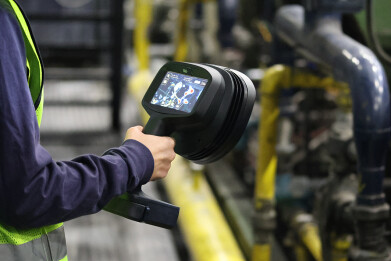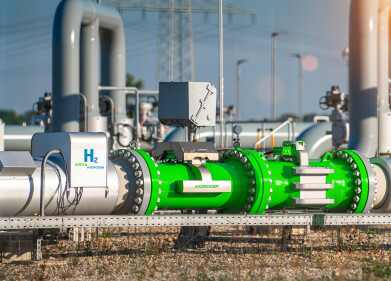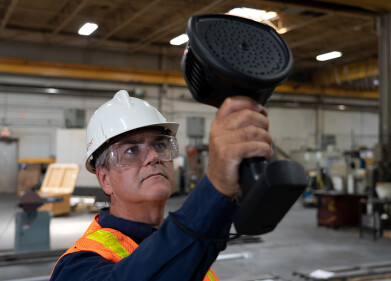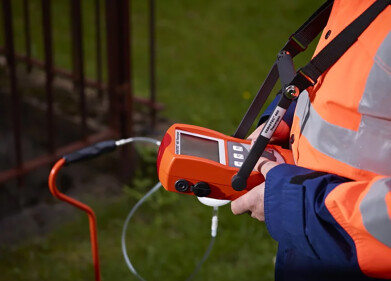Leak detection
The importance of identifying air and gas leaks
Oct 16 2024
If you search the web for ‘How to detect an air leak’, - you will find over 18 million results.
Most search results pointed to one solution, whether solving the problem in a commercial establishment or a domestic home environment: good, old-fashioned soapy water!
This approach may seem outdated, but if you take your car with a slow puncture to a tyre depot, they will probably remove the wheel and spin it in water to discover the leak. This is a simple yet effective, time-proven approach for finding leaks in pressurised systems.
However, not everything can be placed in soapy water. What if a system is losing pressure, yet the lines transporting the compressed air from the source are located ten metres above the ground, so dismantling the system is not an option? Luckily, a fast and effective solution is at hand.
When air, or any gas, leaks from a pressured system, it emits a sound. Bigger leaks can be audible to the human ear and easily identified and rectified accordingly. However, most leaks in high-pressure systems are exceedingly small and inaudible to the human ear. A fine example would be a pressured air system in a large factory that delivers compressed air from a bank of compressors to the various stages of the manufacturing process. There are probably hundreds, even thousands, of connections, such as joints, reducers, valves and elbows, which can leak small amounts of air, reducing the system's pressure.
A single leak will probably make very little difference, but efficiency may be significantly compromised when multiplied by the number of potential leaking joints. A compressor will attempt to compensate for any pressure loss by working harder. However, compressors can be expensive to run and will undoubtedly increase an operator's energy consumption.
In recent years, electricity costs have been much higher in Europe, so most organisations are trying to reduce energy consumption. Senior management will frown upon having a compressor working overtime to compensate for leaks!
These situations are now ubiquitous; one compressor manufacturer has declared that in some industrial settings, as much as 80% of air generated is lost because of leaks. So, identifying these small leaks can make a considerable difference to a company’s energy costs.
While the sound made by a small leak is inaudible to humans, a highly advanced acoustic imaging camera such as the FLIR Teledyne Si2 – LD will quickly and easily identify the source.
This sophisticated instrument was launched earlier this year. The camera can detect leaks of 0.05 litres per minute from as far away as 10 metres, so elevated air lines are no problem for this latest addition to the FLIR acoustic imaging camera range.
The FLIR Teledyne Si2 – LD is even more sensitive for closer measurements and can detect minute leaks of 0.0032 litres per minute from 2.5 metres. The third-generation camera models also feature improved microphones that detect sounds over an extremely wide frequency range of 2 – 130 kHz.
Many plants have dark or dimly lit areas, so FLIR has fitted the new cameras with two powerful LED lights to make component identification easy, regardless of the light conditions,
Of course, it is not just compressed air that the camera can detect; the powerful microphones identify noise emitted by any escaping gas. However, that is not the end of the story; these devices feature integrated software called Industrial Gas Quantification. If the leaking gas is ammonia, hydrogen, helium, or carbon dioxide, all of which are commonly used industrial gases, the software can calculate the financial loss caused by the leak. The operator must enter a few details, such as cost per litre, and the software identifies the amount each leak is causing over a given period.
Financial considerations are only one aspect of the problems created by gas leaks. The previously mentioned gases are all hazardous to human health and present a variety of dangers to staff if they continue to leak. Ammonia and carbon dioxide can cause severe breathing problems and asphyxiation, even in small concentrations. At the same time, hydrogen can explode in the presence of oxygen, so the cost of such issues goes way beyond finances.
Digital Edition
AET 29.2 May 2025
May 2025
Water / Wastewater- From Effluent to Excellence: Microbiological assessment of a containerized modular water reuse pilot system- Without water everything comes to a haltAir Monitoring- Probe Sampli...
View all digital editions
Events
Jun 11 2025 Copenhagen, Denmark
Jun 17 2025 Guangzhou, China
Singapore International Water Week Spotlight 2025
Jun 23 2025 Singapore
Jun 24 2025 Santa Clara, CA, USA
Jun 25 2025 Sao Paulo, Brasil











.jpg)







